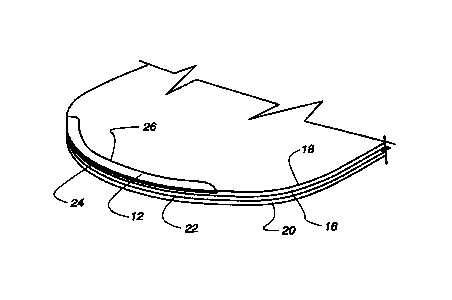Some of the information on this Web page has been provided by external sources. The Government of Canada is not responsible for the accuracy, reliability or currency of the information supplied by external sources. Users wishing to rely upon this information should consult directly with the source of the information. Content provided by external sources is not subject to official languages, privacy and accessibility requirements.
Any discrepancies in the text and image of the Claims and Abstract are due to differing posting times. Text of the Claims and Abstract are posted:
| (12) Patent Application: | (11) CA 2308357 |
|---|---|
| (54) English Title: | SNOW BOARD TIP PROTECTOR |
| (54) French Title: | PROTECTEUR DE SPATULE POUR SURF DES NEIGES |
| Status: | Deemed Abandoned and Beyond the Period of Reinstatement - Pending Response to Notice of Disregarded Communication |
| (51) International Patent Classification (IPC): |
|
|---|---|
| (72) Inventors : |
|
| (73) Owners : |
|
| (71) Applicants : |
|
| (74) Agent: | GOWLING WLG (CANADA) LLPGOWLING WLG (CANADA) LLP |
| (74) Associate agent: | |
| (45) Issued: | |
| (86) PCT Filing Date: | 1998-11-03 |
| (87) Open to Public Inspection: | 1999-05-14 |
| Availability of licence: | N/A |
| Dedicated to the Public: | N/A |
| (25) Language of filing: | English |
| Patent Cooperation Treaty (PCT): | Yes |
|---|---|
| (86) PCT Filing Number: | PCT/US1998/023357 |
| (87) International Publication Number: | WO 1999022826 |
| (85) National Entry: | 2000-05-03 |
| (30) Application Priority Data: | ||||||
|---|---|---|---|---|---|---|
|
A ski device such as a snow board (10) is disclosed which has a tip protector
(12) embedded into the upper surface (18) of each of the tip portions (11) of
the board (10). The tip protector (12) may be incorporated into regular ski
tips or monoski tips as well as on snow boards. The tip protector (12) is a
generally flat curved strip of ductile sheet material bonded to a portion of
the upper suface (18) of the rounded tip portion (11) adjacent to and aligned
with the edge (22) of the device.
L'invention concerne un dispositif de glisse tel qu'un surf des neiges (10) muni d'un protecteur de spatule (12) intégré à la surface supérieure (18) de chacune des parties spatule (11) de la planche (10). Le protecteur de spatule (12) peut être intégré à des spatules de skis classiques tout comme à celle d'un monoski ou d'un surf des neiges. Le protecteur de spatule (12) se présente comme une bande généralement plate et incurvée, faite en un matériau ductile en forme de feuille et collée à une partie de la surface supérieure (18) de la partie spatule arrondie (11), qui est disposée à côté du bord (22) du dispositif et alignée sur celui-ci.
Note: Claims are shown in the official language in which they were submitted.
Note: Descriptions are shown in the official language in which they were submitted.

2024-08-01:As part of the Next Generation Patents (NGP) transition, the Canadian Patents Database (CPD) now contains a more detailed Event History, which replicates the Event Log of our new back-office solution.
Please note that "Inactive:" events refers to events no longer in use in our new back-office solution.
For a clearer understanding of the status of the application/patent presented on this page, the site Disclaimer , as well as the definitions for Patent , Event History , Maintenance Fee and Payment History should be consulted.
| Description | Date |
|---|---|
| Inactive: IPC from MCD | 2006-03-12 |
| Inactive: IPC from MCD | 2006-03-12 |
| Application Not Reinstated by Deadline | 2003-11-03 |
| Time Limit for Reversal Expired | 2003-11-03 |
| Deemed Abandoned - Failure to Respond to Maintenance Fee Notice | 2002-11-04 |
| Letter Sent | 2002-04-03 |
| Inactive: MF/reinstatement fee unallocated - Log 25 deleted | 2002-04-03 |
| Letter Sent | 2001-12-10 |
| Inactive: Office letter | 2001-11-30 |
| Inactive: Office letter | 2001-11-28 |
| Reinstatement Requirements Deemed Compliant for All Abandonment Reasons | 2001-11-23 |
| Deemed Abandoned - Failure to Respond to Maintenance Fee Notice | 2001-11-05 |
| Inactive: Cover page published | 2000-07-14 |
| Inactive: First IPC assigned | 2000-06-22 |
| Inactive: Notice - National entry - No RFE | 2000-06-20 |
| Inactive: Inventor deleted | 2000-06-19 |
| Application Received - PCT | 2000-06-16 |
| Amendment Received - Voluntary Amendment | 2000-06-12 |
| Application Published (Open to Public Inspection) | 1999-05-14 |
| Abandonment Date | Reason | Reinstatement Date |
|---|---|---|
| 2002-11-04 | ||
| 2001-11-05 |
The last payment was received on 2001-11-23
Note : If the full payment has not been received on or before the date indicated, a further fee may be required which may be one of the following
Please refer to the CIPO Patent Fees web page to see all current fee amounts.
| Fee Type | Anniversary Year | Due Date | Paid Date |
|---|---|---|---|
| Basic national fee - small | 2000-05-03 | ||
| MF (application, 2nd anniv.) - small | 02 | 2000-11-03 | 2000-10-19 |
| Reinstatement | 2001-11-07 | ||
| MF (application, 3rd anniv.) - small | 03 | 2001-11-05 | 2001-11-23 |
| Reinstatement | 2001-11-23 |
Note: Records showing the ownership history in alphabetical order.
| Current Owners on Record |
|---|
| WILLIAM H., JR. MUFF |
| Past Owners on Record |
|---|
| None |